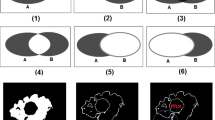Abstract
Purpose
Patient-specific models of anatomical structures and pathologies generated from volumetric medical images play an increasingly central role in many aspects of patient care. A key task in generating these models is the segmentation of anatomical structures and pathologies of interest. Although numerous segmentation methods are available, they often produce erroneous delineations that require time-consuming modifications.
Methods
We present a new geometry-based algorithm for the reliable detection and correction of segmentation errors in volumetric medical images. The method is applicable to anatomical structures consisting of a few 3D star-shaped components. First, it detects segmentation errors by casting rays from the initial segmentation interior to its outer surface. It then classifies the segmentation surface into correct and erroneous regions by minimizing an energy functional that incorporates first- and second-order properties of the rays lengths. Finally, it corrects the segmentation errors by computing new locations for the erroneous surface points by Laplace deformation so that the new surface has maximum smoothness with respect to the rays-length gradient magnitude.
Results
Our evaluation on initial segmentations of 16 abdominal aortic aneurysm and 12 lung tumors in CT scans obtained by both adaptive region-growing and active contours level-set segmentation improved the volumetric overlap error by 66 and 70.5 % respectively, with respect to the ground-truth.
Conclusions
The advantages of our method are that it is independent of the initial segmentation algorithm that covers a variety of anatomical structures and pathologies, that it does not require a shape prior, and that it requires minimal user interaction.








Similar content being viewed by others
References
Pohle R, Toennies K (2001) Segmentation of medical images using adaptive region growing. Proc SPIE Med Imaging 4322:1337–1346
Dodin P, Martel-Pelletier J, Pelletier J, Abram F (2011) A fully automated human knee 3D MRI bone segmentation using the ray casting technique. Med Biol Eng Comput 49(12):1413–1424
Boykov Y, Funka-Lea G (2006) Graph cuts and efficient and image segmentation. Int J Comput Vis 70(2):109–131
Caselles V, Kimmel R, Sapiro G (1997) Geodesic active contours. Int J Comput Vis 22(1):61–79
Freedman D, Zhang T (2005) Interactive graph cut based segmentation with shape priors. Proc IEEE Conf Comput Vis Pattern Recognit 1:755–762
Tsai A, Yezzi A Jr, Wells W, Tempany C, Tucker D, Fan A, Grimson W, Willsky A (2003) A shape-based approach to the segmentation of medical imagery using level sets. IEEE Trans Med Imaging 22(2):137–154
Djabelkhir F, Khamadja, M, Odet C (2007) Level set constrained segmentation using local curvature. In: Proceedings of the IEEE 5th international symposium on image and signal processing and analysis, pp 152–155
El-Zehiry N, Grady L (2010) Fast global optimization of curvature. In: Proceedings of the IEEE conference on computer vision and pattern recognition, pp 3257–3264
Grady L (2006) Random walks for image segmentation. IEEE Trans Pattern Anal Mach Intell 28(11):1768–1783
Top A, Hamarneh G, Abugharbieh R (2011) Active learning for interactive 3D image segmentation. In: Proceedings of the medical image computing and computer-assisted intervention, pp 603–610
Grady L, Funka-Lea G (2006) An energy minimization approach to the data driven editing of pre-segmented images/volumes. In: Proceedings of the medical image computing and computer-assisted intervention, pp 888–895
Heckel F, Braunewell, S, Soza, G, Tietjen C, Hahn HK (2012) Sketch-based image independent editing of 3D tumor segmentations using variational interpolation. In: Proceedings of the eurographics workshop on visual computing for biology and medicine, pp 73–80
Kronman A, Joskowicz L, Sosna J (2013) Image segmentation by mesh segmentation and deformation. In: Medical image computing and computer-assisted intervention (MICCAI 2013). Springer, Berlin, pp 206–213
Kronman A, Joskowicz L, Sosna J (2012) Anatomical structures segmentation by spherical 3D ray casting and gradient domain editing. In: Medical image computing and computer-assisted intervention (MICCAI 2012). Springer, Berlin, pp 363–370
Rana S (2004) Two approximate solutions to the art gallery problem. In: Proceedings of ACM SIGGRAPH posters, p 66
Styner M, Oguz I, Xu S, Brechbühler C, Pantazis D, Levitt J, Shenton M, Gerig G (2006) Framework for the statistical shape analysis of brain structures using SPHARM-PDM. Workshop on medical image computing and computer-assisted intervention. Insight J 1071:242
Loop C (1987) Smooth subdivision surfaces based on triangles
Reuter M, Biasotti S, Giorgi D, Patanèc G, Spagnuolo M (2009) Discrete Laplace Beltrami operators for shape analysis and segmentation. Comput Graph 33(3):381–390
Davis TA (2004) Algorithm 832: Umfpack V4.3—an unsymmetric-pattern multifrontal method. ACM Trans Math Softw 30(2):196–199
Lorensen WE, Cline HE (1987) Marching cubes: a high resolution 3D surface construction algorithm. Comput Graph 21(4):163–169
Acknowledgments
The authors would like to thank Prof. Jacob Sosna, Chairman of the Department of Radiology at the Hadassah-University Medical Center, Jerusalem, Israel, and his staff for providing the CT scans and ground-truth delineations. This work was partially supported by KAMIN Grant 46217, Israeli Ministry of Trade and Industry.
Author information
Authors and Affiliations
Corresponding author
Ethics declarations
Conflict of interest
None of the authors has any conflict of interest. The authors have no personal financial or institutional interest in any of the materials, software or devices described in this article.
Rights and permissions
About this article
Cite this article
Kronman, A., Joskowicz, L. A geometric method for the detection and correction of segmentation leaks of anatomical structures in volumetric medical images. Int J CARS 11, 369–380 (2016). https://doi.org/10.1007/s11548-015-1285-z
Received:
Accepted:
Published:
Issue Date:
DOI: https://doi.org/10.1007/s11548-015-1285-z




